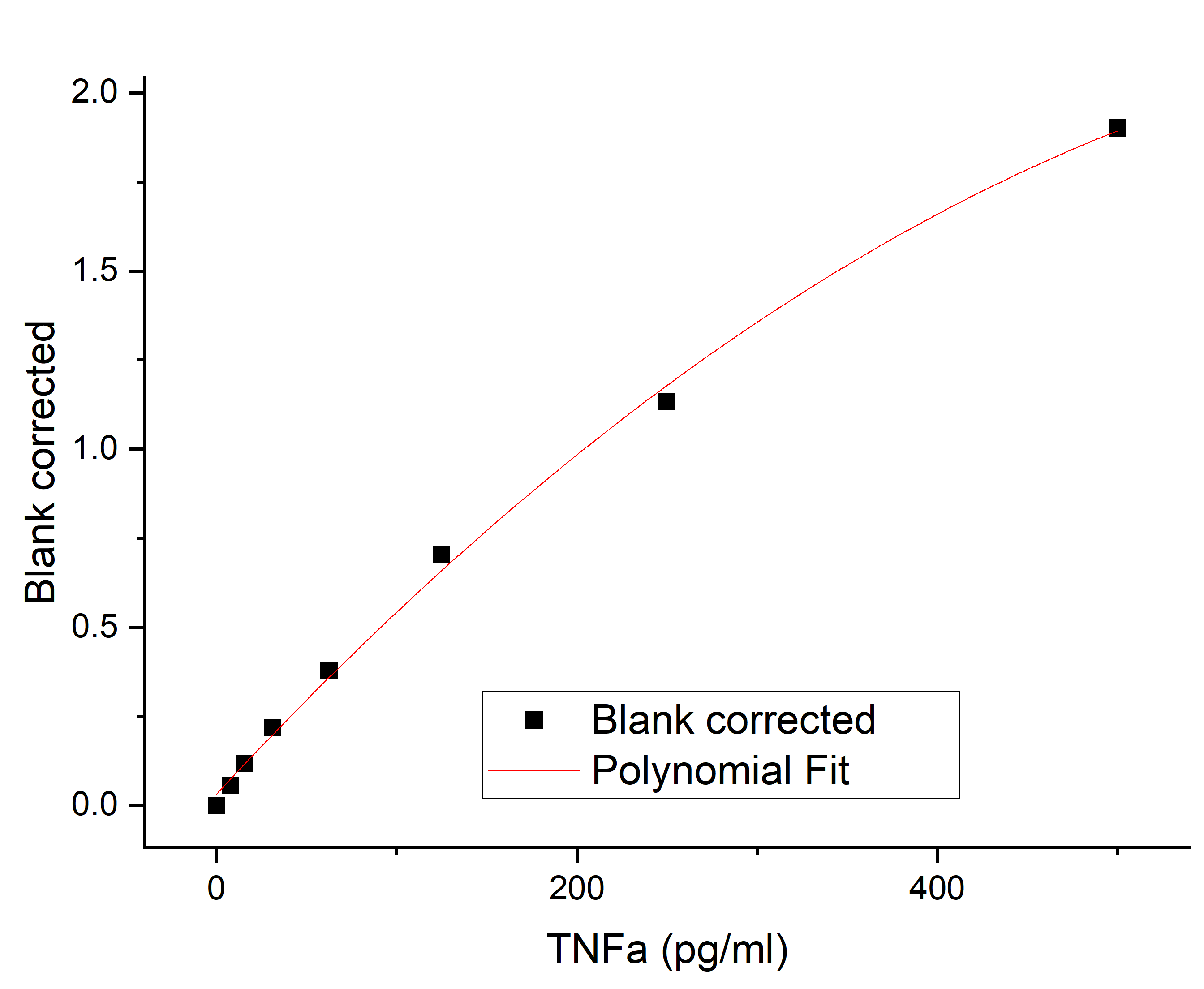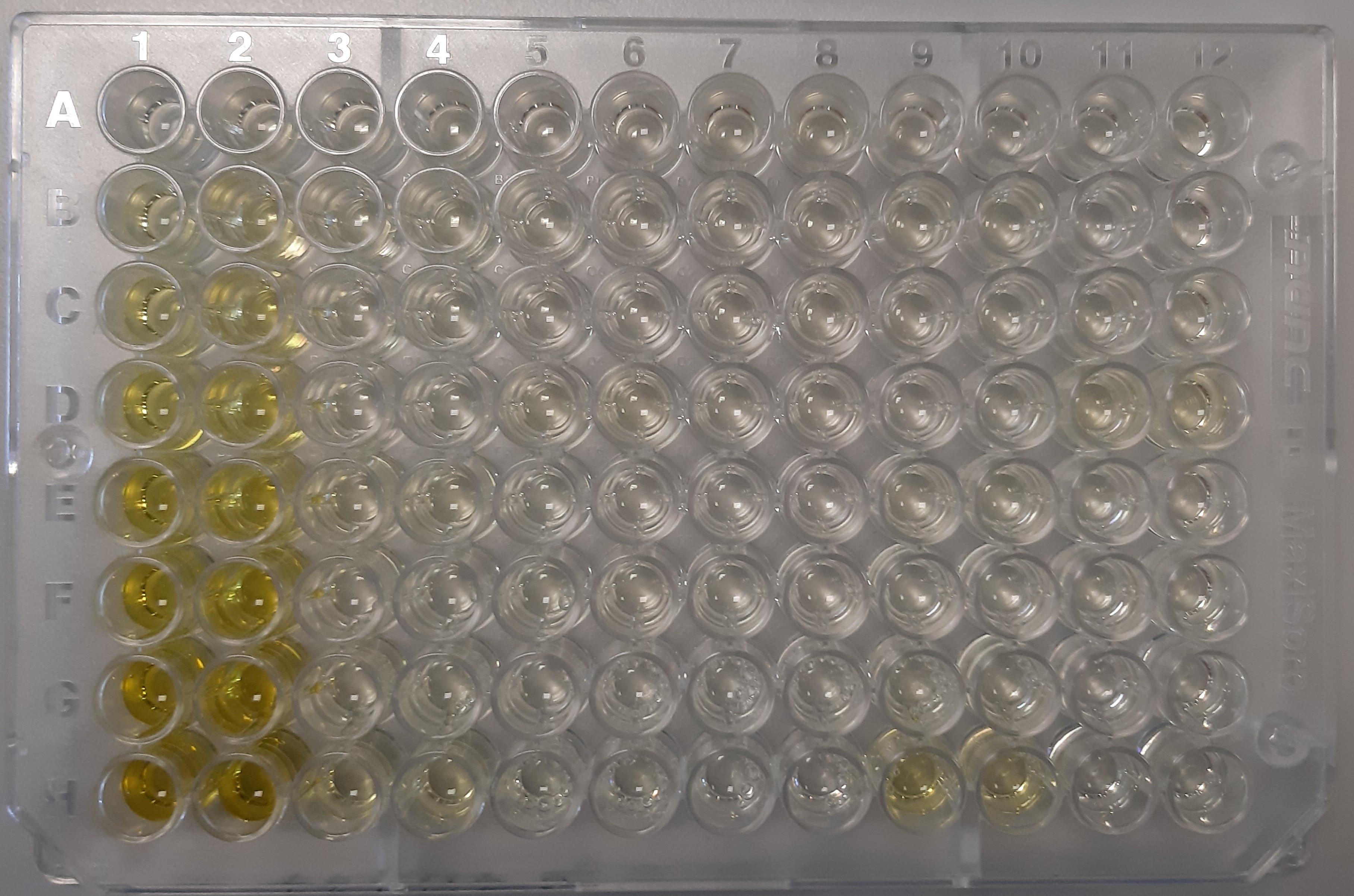Rabbit TNF-alpha DuoSet ELISA Summary
* Provided that the recommended microplates, buffers, diluents, substrates and solutions are used, and the assay is run as summarized in the Assay Procedure provided.
This DuoSet ELISA Development kit contains the basic components required for the development of sandwich ELISAs to measure natural and recombinant rabbit TNF-alpha. The suggested diluent is suitable for the analysis of most cell culture supernate samples. Diluents for complex matrices, such as serum and plasma, should be evaluated prior to use in this DuoSet.
Product Features
- Optimized capture and detection antibody pairings with recommended concentrations save lengthy development time
- Development protocols are provided to guide further assay optimization
- Assay can be customized to your specific needs
- Economical alternative to complete kits
Kit Content
- Capture Antibody
- Detection Antibody
- Recombinant Standard
- Streptavidin conjugated to horseradish-peroxidase (Streptavidin-HRP)
Other Reagents Required
DuoSet Ancillary Reagent Kit 2 (5 plates): (Catalog # DY008) containing 96 well microplates, plate sealers, substrate solution, stop solution, plate coating buffer (PBS), wash buffer, and Reagent Diluent Concentrate 2.
The components listed above may be purchased separately:
PBS: (Catalog # DY006), or 137 mM NaCl, 2.7 mM KCl, 8.1 mM Na2HPO4, 1.5 mM KH2PO4, pH 7.2 - 7.4, 0.2 µm filtered
Wash Buffer: (Catalog # WA126), or 0.05% Tween® 20 in PBS, pH 7.2-7.4
Reagent Diluent: (Catalog # DY995), or 1% BSA in PBS, pH 7.2-7.4, 0.2 µm filtered
Substrate Solution: 1:1 mixture of Color Reagent A (H2O2) and Color Reagent B (Tetramethylbenzidine) (Catalog # DY999)
Stop Solution: 2 N H2SO4 (Catalog # DY994)
Microplates: R&D Systems (Catalog # DY990)
Plate Sealers: ELISA Plate Sealers (Catalog # DY992)
Scientific Data
Product Datasheets
Preparation and Storage
Background: TNF-alpha
Tumor necrosis factor alpha (TNF-α), also known as cachectin and TNFSF2, is the prototypic ligand of the TNF superfamily. It is a pleiotropic molecule that plays a central role in inflammation, apoptosis, and immune system development. TNF-α is produced by a wide variety of immune and epithelial cell types. Human TNF-α consists of a 35 amino acid (aa) cytoplasmic domain, a 21 aa transmembrane segment, and a 177 aa extracellular domain (ECD). Within the ECD, human TNF-α shares 97% aa sequence identity with rhesus and 71% - 92% with bovine, canine, cotton rat, equine, feline, mouse, porcine, and rat TNF-α. The 26 kDa type 2 transmembrane protein is assembled intracellularly to form a noncovalently linked homotrimer. Ligation of this complex induces reverse signaling that promotes lymphocyte costimulation but diminishes monocyte responsiveness.
Cleavage of membrane bound TNF-α by TACE/ADAM17 releases a 55 kDa soluble trimeric form of TNF-α. TNF-α trimers bind the ubiquitous TNF RI and the hematopoietic cell-restricted TNF RII, both of which are also expressed as homotrimers. TNF-α regulates lymphoid tissue development through control of apoptosis. It also promotes inflammatory responses by inducing the activation of vascular endothelial cells and macrophages. TNF-α is a key cytokine in the development of several inflammatory disorders. It contributes to the development of type 2 diabetes through its effects on insulin resistance and fatty acid metabolism.
Assay Procedure
GENERAL ELISA PROTOCOL
Plate Preparation
- Dilute the Capture Antibody to the working concentration in PBS without carrier protein. Immediately coat a 96-well microplate with 100 μL per well of the diluted Capture Antibody. Seal the plate and incubate overnight at room temperature.
- Aspirate each well and wash with Wash Buffer, repeating the process two times for a total of three washes. Wash by filling each well with Wash Buffer (400 μL) using a squirt bottle, manifold dispenser, or autowasher. Complete removal of liquid at each step is essential for good performance. After the last wash, remove any remaining Wash Buffer by aspirating or by inverting the plate and blotting it against clean paper towels.
- Block plates by adding 300 μL Reagent Diluent to each well. Incubate at room temperature for a minimum of 1 hour.
- Repeat the aspiration/wash as in step 2. The plates are now ready for sample addition.
Assay Procedure
- Add 100 μL of sample or standards in Reagent Diluent, or an appropriate diluent, per well. Cover with an adhesive strip and incubate 2 hours at room temperature.
- Repeat the aspiration/wash as in step 2 of Plate Preparation.
- Add 100 μL of the Detection Antibody, diluted in Reagent Diluent, to each well. Cover with a new adhesive strip and incubate 2 hours at room temperature.
- Repeat the aspiration/wash as in step 2 of Plate Preparation.
- Add 100 μL of the working dilution of Streptavidin-HRP to each well. Cover the plate and incubate for 20 minutes at room temperature. Avoid placing the plate in direct light.
- Repeat the aspiration/wash as in step 2.
- Add 100 μL of Substrate Solution to each well. Incubate for 20 minutes at room temperature. Avoid placing the plate in direct light.
- Add 50 μL of Stop Solution to each well. Gently tap the plate to ensure thorough mixing.
- Determine the optical density of each well immediately, using a microplate reader set to 450 nm. If wavelength correction is available, set to 540 nm or 570 nm. If wavelength correction is not available, subtract readings at 540 nm or 570 nm from the readings at 450 nm. This subtraction will correct for optical imperfections in the plate. Readings made directly at 450 nm without correction may be higher and less accurate.
Citations for Rabbit TNF-alpha DuoSet ELISA
R&D Systems personnel manually curate a database that contains references using R&D Systems products. The data collected includes not only links to publications in PubMed, but also provides information about sample types, species, and experimental conditions.
19
Citations: Showing 1 - 10
Filter your results:
Filter by:
-
Intrapleural Fibrinolytic Interventions for Retained Hemothoraces in Rabbits
Authors: De Vera, CJ;Jacob, J;Sarva, K;Christudas, S;Emerine, RL;Florence, JM;Akiode, O;Gorthy, TV;Tucker, TA;Singh, KP;Azghani, AO;Komissarov, AA;Florova, G;Idell, S;
International journal of molecular sciences
Species: Rabbit
Sample Types: Pleural Fluid
-
A Novel Rabbit Model of Retained Hemothorax with Pleural Organization
Authors: De Vera, CJ;Emerine, RL;Girard, RA;Sarva, K;Jacob, J;Azghani, AO;Florence, JM;Cook, A;Norwood, S;Singh, KP;Komissarov, AA;Florova, G;Idell, S;
International journal of molecular sciences
Species: Rabbit
Sample Types: Tissue Homogenates
-
Targeting the PAI-1 Mechanism with a Small Peptide Increases the Efficacy of Alteplase in a Rabbit Model of Chronic Empyema
Authors: Florova, G;De Vera, CJ;Emerine, RL;Girard, RA;Azghani, AO;Sarva, K;Jacob, J;Morris, DE;Chamiso, M;Idell, S;Komissarov, AA;
Pharmaceutics
Species: Rabbit
Sample Types: Pleural Fluid
-
Microgel reinforced zwitterionic hydrogel coating for blood-contacting biomedical devices
Authors: M Yao, Z Wei, J Li, Z Guo, Z Yan, X Sun, Q Yu, X Wu, C Yu, F Yao, S Feng, H Zhang, J Li
Nature Communications, 2022-09-12;13(1):5339.
Species: Rabbit
Sample Types: Plasma
-
Immunization with Virus-Like Particle Vaccine Protects Rabbits against Hepatitis E-3 Virus Infection
Authors: HJ Go, BJ Park, HS Ahn, SH Han, DH Kim, EL Lyoo, DY Kim, JH Kim, JB Lee, SY Park, CS Song, SW Lee, YK Choi, IS Choi
Viruses, 2022-06-29;14(7):.
Species: Rat
Sample Types: Serum
-
Development of a skin- and neuro-attenuated live vaccine for varicella
Authors: W Wang, D Pan, W Fu, X Ye, J Han, L Yang, J Jia, J Liu, R Zhu, Y Zhang, C Liu, J Ye, A Selariu, Y Que, Q Zhao, T Wu, Y Li, J Zhang, T Cheng, H Zhu, N Xia
Nature Communications, 2022-02-11;13(1):824.
Species: Rabbit
Sample Types: Cell Culture Supernates
-
Fat-1 expression alleviates atherosclerosis in transgenic rabbits
Authors: C Zhang, X Wang, S Sun, Y Fu, Y Wu, S Zhao, X Fan, E Liu
Journal of Cellular and Molecular Medicine, 2022-01-18;0(0):.
Species: Rabbit
Sample Types: Plasma
-
Protective effects of Hirudin against compartment syndrome in rabbits through the activation of Nrf2/HO-1
Authors: J Du, Z Kang, L Huang, F Zhou, X Feng, J Huang
Injury, 2021-11-23;0(0):.
Species: Rabbit
Sample Types: Tissue Homogenates
-
Precision targeting of the plasminogen activator inhibitor-1 mechanism increases efficacy of fibrinolytic therapy in empyema
Authors: G Florova, RA Girard, AO Azghani, K Sarva, A Buchanan, S Karandasho, CJ DeVera, D Morris, M Chamiso, K Koenig, DB Cines, S Idell, AA Komissarov
Physiological Reports, 2021-05-01;9(9):e14861.
Species: Rabbit
Sample Types: Pleural Fluid
-
Bacterial virulence plays a crucial role in MRSA sepsis
Authors: GYC Cheung, JS Bae, R Liu, RL Hunt, Y Zheng, M Otto
PloS Pathogens, 2021-02-25;17(2):e1009369.
Species: Rabbit
Sample Types: Serum
-
Gelatin-epigallocatechin gallate nanoparticles with hyaluronic acid decoration as eye drops can treat rabbit dry-eye syndrome effectively via inflammatory relief
Authors: HY Huang, MC Wang, ZY Chen, WY Chiu, KH Chen, IC Lin, WV Yang, CC Wu, CL Tseng
Int J Nanomedicine, 2018-11-08;13(0):7251-7273.
Species: Rabbit
Sample Types: Tissue Homogenates
-
Salusin-? Inhibits Proliferation and Migration of Vascular Smooth Muscle Cell via Akt/mTOR Signaling
Authors: S Gao, L Xu, Y Zhang, Q Yu, J Li, H Guan, X Wang, D Cheng, Y Liu, L Bai, R Wang, J Fan, S Zhao, E Liu
Cell. Physiol. Biochem., 2018-11-01;50(5):1740-1753.
Species: Rabbit
Sample Types: Plasma
-
S100B regulates inflammatory response during osteoarthritis via fibroblast growth factor receptor 1 signaling
Authors: L Zhu, Z Weng, P Shen, J Zhou, J Zeng, F Weng, X Zhang, H Yang
Mol Med Rep, 2018-10-01;18(6):4855-4864.
Species: Rabbit
Sample Types: Synovial Fluid
-
Implant delivering hydroxychloroquine attenuates vaginal T lymphocyte activation and inflammation
Authors: Y Chen, YL Traore, S Yang, J Lajoie, KR Fowke, DW Rickey, EA Ho
J Control Release, 2018-03-13;0(0):.
Species: Rabbit
Sample Types: Cervicovaginal Fluid
-
Methylene blue relieves the development of osteoarthritis by upregulating lncRNA MEG3
Authors: X Li, C Tang, J Wang, P Guo, C Wang, Y Wang, Z Zhang, H Wu
Exp Ther Med, 2018-03-02;15(4):3856-3864.
Species: Rabbit
Sample Types: Tissue Homogenates
-
Role of Acupoint Area Collagen Fibers in Anti-Inflammation of Acupuncture Lifting and Thrusting Manipulation
Authors: F Wang, GW Cui, L Kuai, JM Xu, TT Zhang, HJ Cheng, HS Dong, GR Dong
Evid Based Complement Alternat Med, 2017-04-04;2017(0):2813437.
Species: Rabbit
Sample Types: Serum
-
Synergistic Effect of Artificial Tears Containing Epigallocatechin Gallate and Hyaluronic Acid for the Treatment of Rabbits with Dry Eye Syndrome
Authors: Ching-Li Tseng
PLoS ONE, 2016-06-23;11(6):e0157982.
Species: Rabbit
Sample Types: Tissue Homogenates
-
Solvent/Detergent Virally Inactivated Serum Eye Drops Restore Healthy Ocular Epithelium in a Rabbit Model of Dry-Eye Syndrome
Authors: CL Tseng, ZY Chen, TY Renn, SH Hsiao, T Burnouf
PLoS ONE, 2016-04-21;11(4):e0153573.
Species: Rabbit
Sample Types: Tissue Homogenates
-
Extracellular hemoglobin - mediator of inflammation and cell death in the choroid plexus following preterm intraventricular hemorrhage.
Authors: Gram M, Sveinsdottir S, Cinthio M, Sveinsdottir K, Hansson S, Morgelin M, Akerstrom B, Ley D
J Neuroinflammation, 2014-12-02;11(1):200.
Species: Rabbit
Sample Types: Tissue Homogenates
FAQs
No product specific FAQs exist for this product, however you may
View all ELISA FAQsReviews for Rabbit TNF-alpha DuoSet ELISA
Average Rating: 5 (Based on 2 Reviews)
Have you used Rabbit TNF-alpha DuoSet ELISA?
Submit a review and receive an Amazon gift card.
$25/€18/£15/$25CAN/¥75 Yuan/¥2500 Yen for a review with an image
$10/€7/£6/$10 CAD/¥70 Yuan/¥1110 Yen for a review without an image
Filter by:















